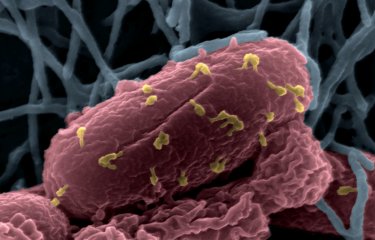Klebsiella bacteria are responsible for some of the most antibiotic-resistant infections. A major study on intestinal colonization by Klebsiella has shed light on human carriage of these strains in the community (i.e. outside hospitals) in low-income countries. This study reveals that controlling Klebsiella carriage is a complex challenge.
It is normal to find Klebsiella bacteria inhabiting the human digestive tract. Contrary to similar bacteria such as Salmonella, which invariably cause infections whenever present (these are considered genuine pathogens), Klebsiella are said to be opportunistic as they only cause infections in certain circumstances, e.g. in patients whose immune system is compromised, in those undergoing surgical procedures, or in neonates whose "barrier" gastrointestinal flora has not yet formed. In such cases, Klebsiella invade other organs, potentially causing infections of the blood, urine or respiratory system.
Klebsiella – multiple antibiotic-resistant bacteria
The problem is that Klebsiella bacteria are responsible for some of the most antibiotic-resistant infections. The most resistant blood infections, which even resist powerful carbapenem antibiotics, are difficult to treat, leading to mortality rates in excess of 50%. They are often spread in hospitals, where they accumulate multiple resistance genes.
The extraordinary resistance exhibited by Klebsiella, a bacterial genus in which resistance genes that have become a global problem were observed for the first time, can be attributed to their ability to colonize various ecological niches, where they acquire resistance genes from other environmental or animal-borne bacteria. These effective colonizers of the human digestive tract colonize the body through environmental exposure, food, or periods spent in hospital. They therefore present a risk of multidrug-resistant infections, especially in neonates at the time of birth if the mother is "colonized". Moreover, they are capable of passing on their resistance genes to other, genuinely pathogenic bacteria in the digestive tract.
Identifying Klebsiella strains carried by humans in the community, especially in low-income countries
Until recently, very little was known about the identity of the largest reservoir of Klebsiella strains, namely those carried by humans in the community (outside hospitals), especially in low-income countries. Knowledge was limited regarding the frequency of carriage, the frequency of resistant strains among those present, and their genetic identity. In contrast, a great deal is known about strains causing infections. However, these represent the tip of the iceberg.
A major screening study of Klebsiella carriage funded by the Institut Pasteur (ACIP) was conducted to shed light on the hidden population of Klebsiella. This was carried out jointly by the Biodiversity and Epidemiology of Bacterial Pathogens Unit (Sylvain Brisse, Institut Pasteur), the Epidemiology and Modeling of Bacterial Evasion to Antimicrobials Unit (Bich-Tram Huynh, Institut Pasteur, Inserm, and University of Saint-Quentin-en-Yvelines), and the epidemiological and bacteriological units of the Institut Pasteur de Madagascar, the Institut Pasteur du Cambodge, and the Institut Pasteur de Dakar. "For the purposes of this study, we drew on a mother-child cohort followed up through the BIRDY project on bacterial infections in neonates in low-income countries," explains Sylvain Brisse.
In total, 911 pregnant women from rural and urban areas in Madagascar, Cambodia and Senegal were tested using an original methodology enabling all Klebsiella strains to be detected for the first time, and not just those resistant to bacteria. "This study revealed that over half of individuals carried Klebsiella asymptomatically and almost a third of these strains were resistant to at least one antibiotic." Genomic sequencing analyses performed on some 500 strains revealed resistance genes carried by digestive tract Klebsiella.
Moreover, the Klebsiella carried by human communities is extremely diverse, since virtually every individual carries a unique strain. "In terms of risk factors for Klebsiella carriage, various types of exposure (contact with food or animals living in proximity with humans) may play a role in transmission. However, no common types of exposure were identified in all countries, suggesting different sources in different countries," comments Bich-Tram Huynh.
This study sheds new light on the role of Klebsiella carriage in the development of antibiotic resistance, and relationships between colonizing and infectious strains. It reveals that controlling Klebsiella carriage is a complex challenge.
Source
Klebsiella pneumoniae carriage in low-income countries: antimicrobial resistance, genomic diversity and risk factors, Gut Microbes, May 13,2020
Bich-Tram Huynh a, Virginie Passet b, Andriniaina Rakotondrasoa c, Thierno Diallo d, Alexandra Kerleguer e, Melanie Hennart b, Agathe De Lauzanne f, Perlinot Herindrainy g, Abdoulaye Seck d, Raymond Berciond, Laurence Borand f, Maria Pardos de la gandara h, Elisabeth Delarocque Astagneau a, Didier Guillemot a, Muriel Vray i , Benoit Garinc, Jean-Marc Collardc, Carla Rodrigues b, and Sylvain Brisseb
a. Institut Pasteur, INSERM, Université de Versailles Saint Quentin (UVSQ), France. Epidemiology and Modelling of Antibacterial Evasion. CESP - U1018 « Echappement aux anti-infectieux et pharmacoépidémiologie »;
b. Institut Pasteur, Biodiversity and Epidemiology of Bacterial Pathogens, Paris, France;
c. Experimental Bacteriology Unit, Institut Pasteur Madagascar;
d. Laboratory of Medical Biology, Institut Pasteur De Dakar, Dakar, Senegal;
e. Medical Biology Unit, Institut Pasteur du Cambodge, Phnom Penh, Cambodia;
f. Epidemiology & Public Health Unit, Institut Pasteur du Cambodge, Phnom Penh, Cambodia;
g. Epidemiology & Public Health Unit, Institut Pasteur Madagascar;
h. Institut Pasteur, Centre National de Référence des Escherichia coli, Shigella et Salmonella, Paris, France;
i. Epidemiology & Public Health Unit, Institut Pasteur de Dakar, Dakar, Sénégal.








